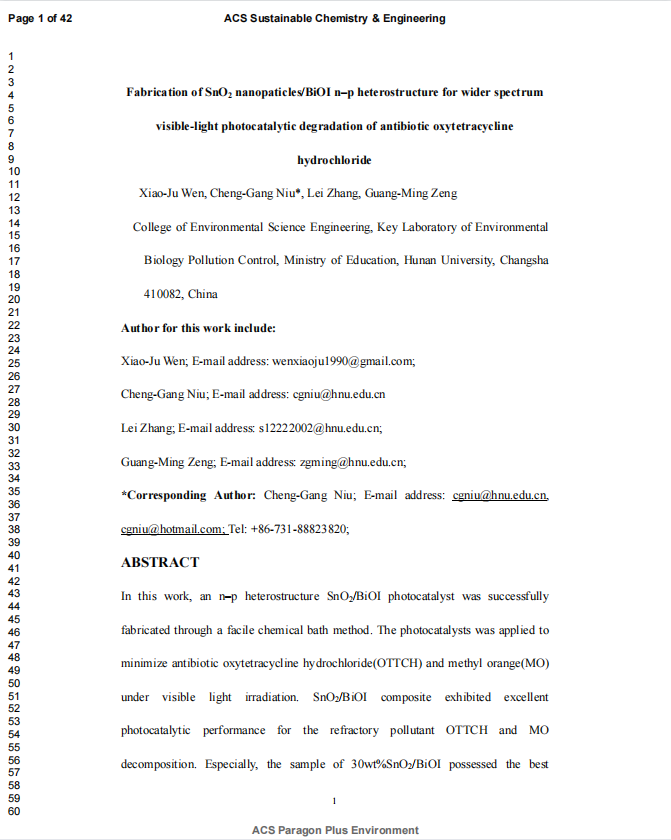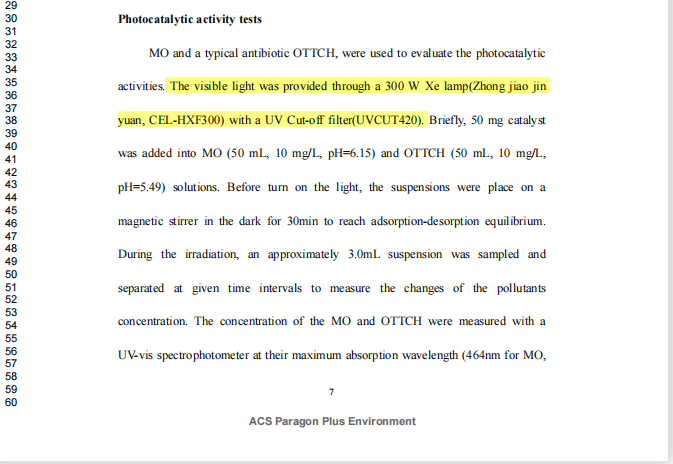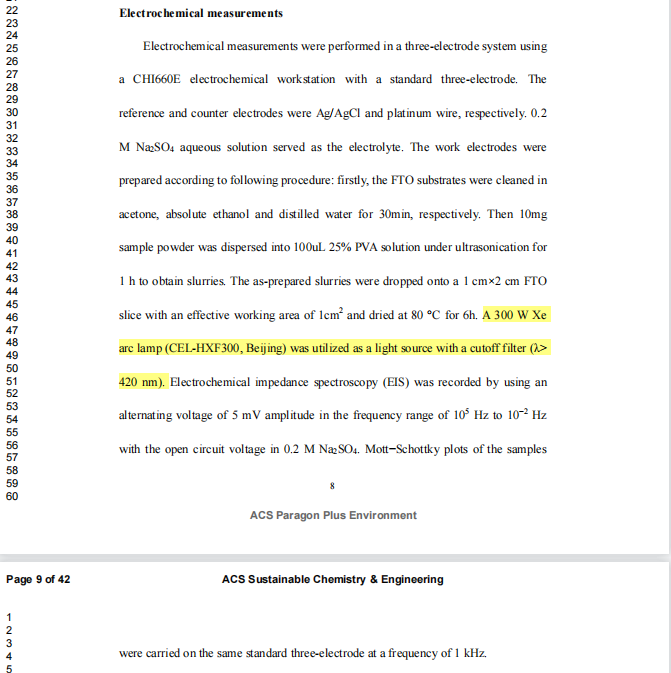Service hotline
+86 18518316054
 Current location : Home page > Resources > Papers > Fabrication of SnO2 Nanopaticles BiOI n–p Heterostructure for Wider Spectrum Visible-Light Photocatalytic Degradation of Antibiotic Oxytetracycline Hydrochloride
Current location : Home page > Resources > Papers > Fabrication of SnO2 Nanopaticles BiOI n–p Heterostructure for Wider Spectrum Visible-Light Photocatalytic Degradation of Antibiotic Oxytetracycline Hydrochloride
Xiao-Ju Wen, Cheng-Gang Niu*, Lei Zhang, Guang-Ming Zeng College of Environmental Science Engineering, Key Laboratory of Environmental Biology Pollution Control, Ministry of Education, Hunan University, Changsha 410082, China
ABSTRACT
In this work, an n–p heterostructure SnO2/BiOI photocatalyst was successfully fabricated through a facile chemical bath method. The photocatalysts was applied to minimize antibiotic oxytetracycline hydrochloride(OTTCH) and methyl orange(MO) under visible light irradiation. SnO2/BiOI composite exhibited excellent photocatalytic performance for the refractory pollutant OTTCH and MO decomposition. Especially, the sample of 30wt%SnO2/BiOI possessed the best photocatalytic performance in all the obtained catalysts. Several reaction parameters affecting OTTCH degradation such as initial concentration, ion species and concentration were investigated systematically. The optical and electrical properties of materials demonstrate that the transfer rate of electron-hole pairs dramatically improve though forming an n–p junction in SnO2/BiOI hybrid. Moreover, the energy band alignments of SnO2/BiOI junction were confirmed via combining DRS and XPS analysis, which provided strong support for the proposed mechanism. This work could provide a new approach to construct new p–n junction photocatalysts and a reference for the study of other heterojunction catalysts.
Keywords: SnO2; BiOI; p-n junction; Photocatalysis; Oxytetracycline hydrochloride.
INTRODUCTION
Oxytetracycline hydrochloride(OTTCH), one of the broad-spectrum antibiotic, especially employed in veterinary medicine.1 Because of its high stability, a large amount of them cannot be biologically degraded or eliminated in treatment plants, ending up in effluents of lakes and rivers.2 It can seriously pose a threat to a large number of living organisms. Besides, traditional treatment processes is refractory to disposal of it.3 Thereby, it is strongly desired to search for an efficient and cost-effective method to destruct its complex structure and remove its biotoxicity. Especially, photocatalytic degradation has become hot spot because it offers an economic and environmentally friendly solution.4-5 Unfortunately, traditional photocatalysts TiO2 only utilize ultraviolet light which just accounts for 3-5% of the solar light.6 As a result, visible light-driven(VLD) photocatalysts have aroused widespread concern.
BiOI, a p-type semiconductor, has been demonstrated to be a promising VLD photocatalyst owing to its strong visible-light response, non-toxicity.7-8 Unfortunately, the photocatalytic performance of bare BiOI is still unsatisfied owing to its fast recombination rate of electron-hole pairs.9 Generally, constructing semiconductor heterostructure is effective in accelerating photoinduced electron-hole pair’s separation efficiency. Particularly, fabrication of BiOI-based p–n junction structure has been validated a very efficient approach to overcome the detrimental effects inherent to BiOI and further enhanced its photocatalytic activity. For instance, Ao and his coworkers reported novel p-n heterojunction BiOI/La2Ti2O7 composite and its highly photocatalytic performance for multiple organic pollutants degradation under visible light irradiation.10 Lately, Wen at al successfully designed BiOI/CeO2 p-n junction photocatalyst via a simple method and the catalyst displayed highly photocatalytic activity for pollutants degradation.11 Therefore, fabrication of p-n heterostructure through combining BiOI to another semiconductor with suitable valence band and conduction band positions is a promising strategy for acquiring a good visible light-driven(VLD) photocatalyst. Among various candidate, Tin oxide (SnO2), a traditional intrinsic n-type semiconductor material, is a possible candidate, which has been widely used in various fields such as energy storage, gas sensors, electronics, solar cells, and photocatalysis.12-16 Normally, pure SnO2 cannot be easily used as VLD photocatalysis due to its wide band gap. 17 Fortunately, SnO2 has high electrical conductivity, which is beneficial to improve charge carrier transportation.18 By means of coupled it with visible light-driven(VLD) photocatalysts, it can facilitate the separation of photo-induced electron–hole pairs in system, consequently enhancing the photocatalytic efficiency, such as SnO2/g-C3N4, 19-20 Ag3PO4/SnO2, 21 SnO2/Cu2O,22 and SnO2/Co3O4. 23 All in all, SnO2 may be a good candidate for fabricating p-n junction towards BiOI.
Based on the above narration, we successfully fabricated SnO2/BiOI n-p heterojunction by means of loading SnO2 nanoparticles on the surface of BiOI nanosheets. The SnO2/BiOI composites display enhanced photocatalytic performance towards MO and OTTCH degradation under visible light irradiation. Subsequently, micro-structure, surface chemical states, Specific surface area, optical and photoelectrocatalytic properties of the heterojunction system were systematically studied. Meanwhile, several factors that affect the OTTCH degradation have also been investigated in detail. The synergistic interaction and an alternative visible-light-induced photocatalytic mechanism were also discussed.
EXPERIMENTAL
Materials
Bismuth nitrate pentahydrate (Bi(NO3)3·5H2O), Tin chloride pentahydrate (SnCl4·5H2O), Sodium hydroxide (NaOH), polyvinyl alcohol (PVA), ethylene glycol (EG), ethanol, sodium sulfate (Na2SO4) potassium iodide (KI), isopropyl alcohol (IPA), sodium oxalate (Na2C2O4), p-benzoquinone (BQ), methyl orange (MO), oxytetracycline hydrochloride(OTTCH) were all purchased from Shanghai chemical Reagents Co., Ltd. All ultrapure water used in all the experiments was obtained from a Milli-Q ultrapure (18.2 MΩ cm) system.
Synthesis of pure SnO2
SnO2 was synthesized via a hydrothermal method according to following procedure. Firstly, 10mmol SnCl4·5H2O and 50mmol NaOH dissolved in 50mL deionized water, respectively. After the two solutions were mixed, 50 mL ethanol solution was added to the mixture solution. Then, the resulting mixture was sealed in a 200 mL Teflon-lined stainless-steel autoclave and maintained at 160 °C for 12 h. Finally, the resulting precipitates were obtained through vacuum filtration. After washing with deionized water and absolute ethanol several times, the obtained precipitate was dried at 70 °C for 12 h.
Fabrication of BiOI/SnO2 p-n junction
SnO2 nanoparticles were loaded in situ on the BiOI nanosheets by a facile chemical bath method. In brief, 1mmol SnO2 was ultrasonically dispersed in 40mL of distilled water to form a uniform solution A. Meanwhile, 1mmol Bi(NO3)3·5H2O and KI were dissolved in 20mL ethylene glycol and get a clear yellow solution. Then the solution was added dropwise to the solution A under vigorous stirring. The mixture was strong stirred for 30 minutes at room temperature. Afterwards, the mixture was stirred in an water bath at 80℃ for 2 h. After cooling down to room temperature, the product was collected by vacuum filtration and washed several times with ultrapure water and alcohol. Eventually the 30wt%SnO2/BiOI samples were obtained after dried at 70℃ for 12h. The schematic diagram for preparation of the SnO2/BiOI junction is illustrated in Scheme 1. By changing the weight of SnO2, different weight percentage ratio of SnO2/BiOI composites (15wt%, 45wt% and 60wt %) were obtained, respectively. The pure BiOI was prepared by the same method described above without the addition of SnO2 precursor.
Scheme 1. Schematic illustration for the preparation procedure of the SnO2/BiOI p-n junction
For comparison, a mechanically physically mixed SnO2 and BiOI sample (SnO2/BiOI weight percentage ratio = 30wt%, denoted as Mixture) was prepared. .
Photocatalytic activity tests
MO and a typical antibiotic OTTCH, were used to evaluate the photocatalytic activities. The visible light was provided through a 300 W Xe lamp(Zhong jiao jin yuan, CEL-HXF300) with a UV Cut-off filter(UVCUT420).


Briefly, 50 mg catalyst was added into MO (50 mL, 10 mg/L, pH=6.15) and OTTCH (50 mL, 10 mg/L, pH=5.49) solutions. Before turn on the light, the suspensions were place on a magnetic stirrer in the dark for 30min to reach adsorption-desorption equilibrium. During the irradiation, an approximately 3.0mL suspension was sampled and separated at given time intervals to measure the changes of the pollutants concentration. The concentration of the MO and OTTCH were measured with a UV-vis spectrophotometer at their maximum absorption wavelength (464nm for MO,356 nm for OTTCH). The amount of adsorption is excluded when the degradation efficiency is calculated. The degradation efficiency could be calculated according to the following equation:


RESULTS AND DISCUSSION
The crystal structure of the SnO2 as well as BiOI and 30wt%SnO2/BiOI composites were analyzed using XRD, as displayed in Fig.1. All the XRD peaks of pure SnO2 could well correspond to the tetragonal phase (JCPDS 01-0625).24 In pure BiOI, the XRD peaks could be indexed to the tetragonal BiOI (JCPDS 73-2062).25 For the patterns of composites, some new typical diffraction peak can be observed at 2θ=26.2°, 33.6° and 51.4°, which were ascribed to the (110), (101) and (211) crystal facet of SnO2 phase, respectively. It is noteworthy that with the SnO2 weight increasing, the diffraction peak of SnO2 became more remarkable. However, the diffraction peaks intensity of SnO2 is weak, which is due to lower crystallinity. The average crystallite size of the pure SnO2 was calculated by Scherrer’s formula.